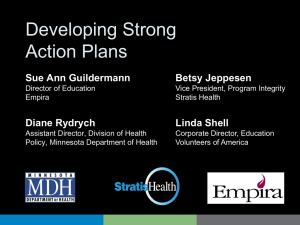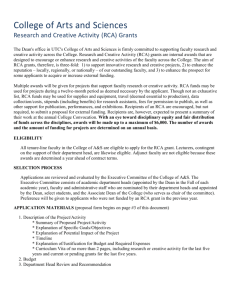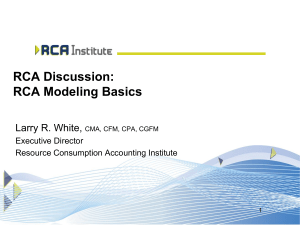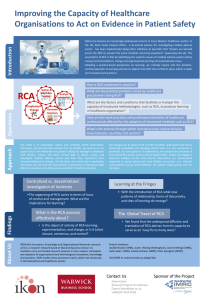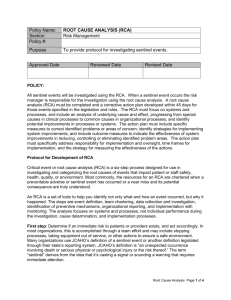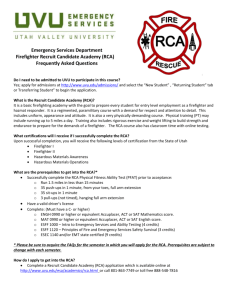And We WONT All Fall Down - Minnesota Department of Health
advertisement
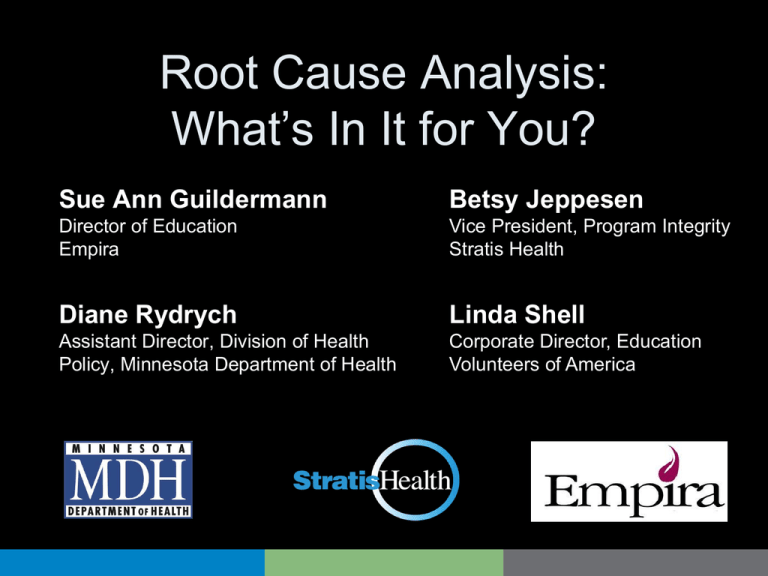
Root Cause Analysis: What’s In It for You? Sue Ann Guildermann Betsy Jeppesen Director of Education Empira Vice President, Program Integrity Stratis Health Diane Rydrych Linda Shell Assistant Director, Division of Health Policy, Minnesota Department of Health Corporate Director, Education Volunteers of America Empira Fall Prevention Program: The Advantages of RCA In Action • • • • • • Education Collaboration Data Collection & Analysis Financial Implication Culture Change (driven by RCA) Hurdles & Challenges 1. Education • All staff, all departments receive education on RCA – everyone learns the process • Ownership in the RCA process by all staff – both leadership and direct staff – one department does not do it all • Multi-factorial approach to falls prevention – not just a clinical approach! • Share information: we all learn from each other – from our mistakes, triumphs, successes, errors – to format it into a standard of care • Other stakeholders: Residents, Families, MDs & NPs, MDH surveyors, LTC providers 2. Collaboration Facility Interdisciplinary Team You’re not solving the problems alone Shared decision-making process It’s not just a nursing program/process anymore Silos disappear QA focuses on RCA process For solutions – not just statistics Leaders across companies meet On an ad hoc basis More involvement & emphasis on program 3. Data Collection & Analysis We have a unique and robust ability to collect, audit ,and analyze data using the RCA process CMS Facility QM & QI Reports: 1.2 Prevalence of Falls 2.1 Incidence of Depression 9.1 Worsening ADLs 9.3 Worsening Room Movement Fall Scene Investigation Report (FSI) Falls Monthly Tracking Report & Fall Summary Report Resident Falls per 1,000 days Annual CMS surveys & OHFC complaints What does all this extra work mean to me? “How do I benefit from this data collection and increased documentation?” ? Results* (after 18 months) QI 1.2: Prevalence of Falls (number of residents who have fallen) – decreased by 15% QI 2.1: Incidence of Depression – decreased 15% QI 9.1: Worsening ADLs – decreased 12% QI 9.3: Worsening Room Movement – decreased 13% Falls per 1,000 resident days (number of falls that occurred) – decreased by 14% Recurrent Falls Tracking – double digits to single digit numbers * Compared to baseline stats prior to start of program 4. Financial Implications • Cost of a Fall: – Clinical care following fall = $10,000 - $24,000 – Takes more staff time and more staffing hours – CMS & OHFC follow-ups – Decline in condition: ADLs, mood, cognitive – More legal expenses – Diagnostic requirements – Poor public relations and reputation – More equipment needs – Education and training – More risk management • Benefits of Not Falling: – Less staff time for follow up care when no fall occurs – Less CMS & OHFC oversight – Healthier resident condition – Fewer legal expenses – Less stress on resources – Improved job satisfaction and retention – Improved customer relations – Improved reputation for quality care – Less risk management A Resident Has Fallen What Do You Do? (Old system prior to RCA.) 5. Culture Change (driven by RCA) RCA transforms a culture that reacts to problems into a culture that solves problems before they escalate. Aiming performance improvement operations at root causes is more effective than merely treating the symptoms of problems. Problems are best solved by eliminating and correcting the root causes, as opposed to merely addressing the obvious symptoms with scatter-gun approaches to solutions. RCA is performed with conclusions and causes and supported by documented, evidence-based practice. Tip of the Iceberg We only see the tip of what is really there Keep looking Keep digging until you find the real cause(s) of this particular fall, this particular incident TITANIC – Why Did it Sink? Every System Is Perfectly Designed to Get the Results It Achieves We need to ask, “Where did the system fail?” A true story of RCA in action – or when the system failed. Hurdles and Challenges • RCA competency – Root Cause Analysis vs. Just Tell Me What To Do – Scatter gun approach to interventions vs. matching interventions to root cause of fall • Staff resists change – A tendency to return to the old ways of doing things • Sustainability: building systems (redundancy) – It becomes part of the culture • Not just a nursing program any more – Get everyone on board • OSHA Safe Patient Handling vs. reduction in resident independence = falls Questions? Sue Ann Guildermann , Director of Education, Empira 952-259-4477 sguilder@empira.org www.empira.org Betsy Jeppesen Vice President, Program Integrity Stratis Health 952-853-8510 or 877-787-2847 bjeppesen@stratishealth.org www.stratishealth.org Diane Rydrych, Assistant Director, Division of Health Policy, Minnesota Department of Health 651-201-3564 Diane.rydrych@state.mn.us www.health.state.mn.us/patientsafety Linda Shell Corporate Director, Education and Learning Volunteers of America 651-503-8885 lshell@voa.org Protecting, maintaining and improving the health of all Minnesotans. Stratis Health is a nonprofit organization that leads collaboration and innovation in health care quality and safety, and serves as a trusted expert in facilitating provement for people and communities.

